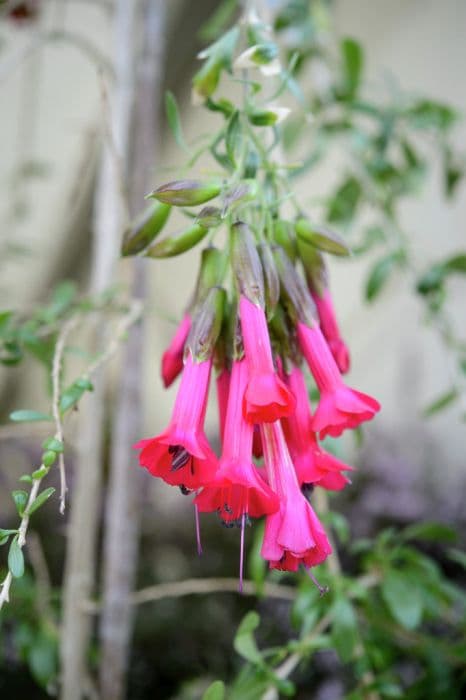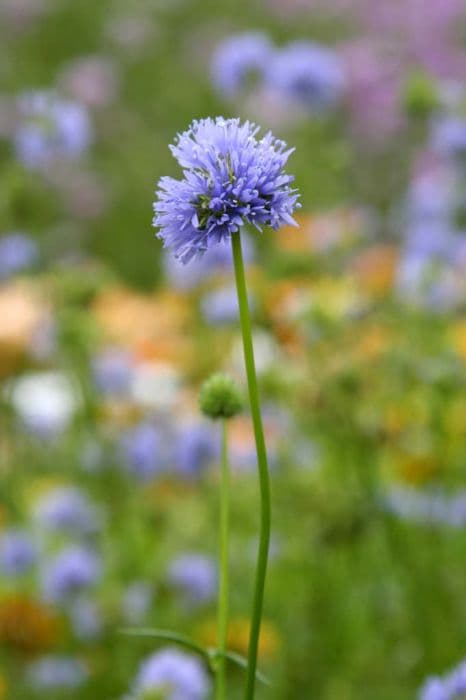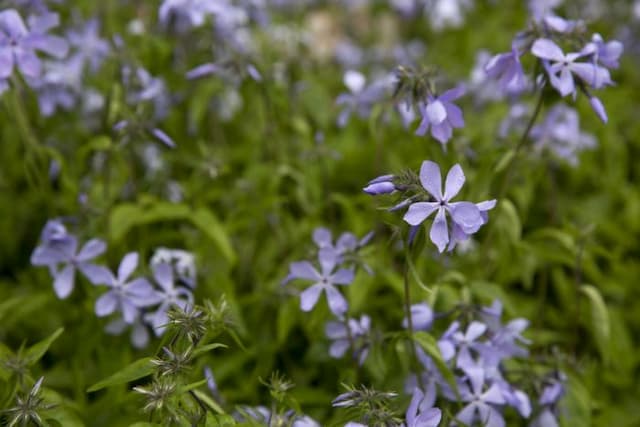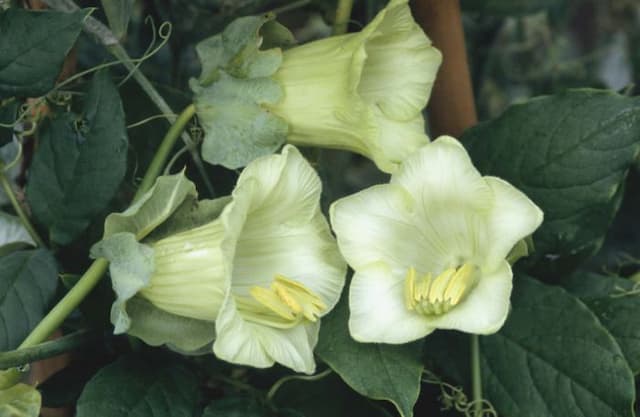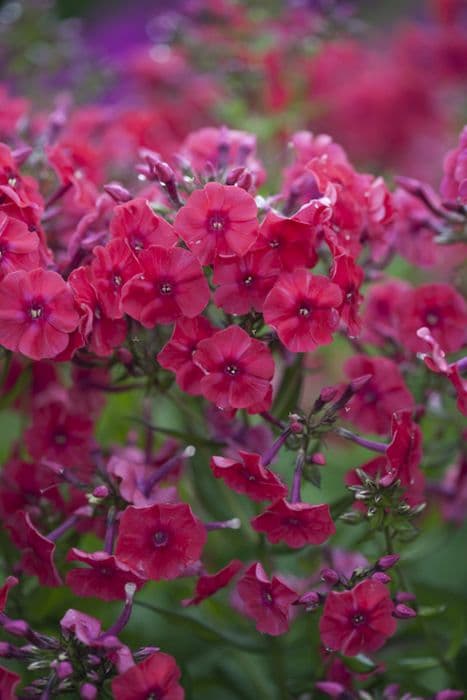Garden Phlox Phlox × arendsii 'Luc's Lilac'

ABOUT
Phlox × arendsii 'Luc's Lilac' is a hybrid variety of garden phlox that boasts showy blooms in a delicate lilac color. The flowers are densely packed in clusters atop sturdy stems, creating a visually stunning display. Each individual flower is small, with a tubular base that flares out into five rounded, overlapping petals, giving them a classic phlox shape. The blossoms emit a sweet fragrance that can attract butterflies and hummingbirds to the garden. The leaves of 'Luc's Lilac' are lance-shaped, with a smooth texture and a rich green color that provides a beautiful contrast to the light purple flowers. They are arranged oppositely on the stems, which gives the plant a full and lush appearance. The overall form of the plant is clumping, with the blooms forming a rounded or dome-like shape as they rise above the foliage. This phlox variety's visual appeal makes it a popular choice for garden borders, flower beds, and as a cut flower for indoor arrangements.
About this plant
 Names
NamesFamily
Polemoniaceae
Synonyms
Garden Phlox, Summer Phlox, Tall Phlox, Perennial Phlox
Common names
Phlox × arendsii 'Luc's Lilac'
 Toxicity
ToxicityTo humans
Garden Phlox is generally considered non-toxic to humans. There is no significant evidence indicating that Phlox × arendsii 'Luc's Lilac' or other garden phlox varieties possess toxic properties that would lead to poisoning upon ingestion. Therefore, accidental consumption of parts of this plant is unlikely to cause harmful effects in humans.
To pets
Garden Phlox, including the variety Phlox × arendsii 'Luc's Lilac', is not known to be toxic to pets such as dogs and cats. It does not contain any known toxins that could cause poisoning in animals. If a pet ingests parts of this plant, it is unlikely to experience significant adverse symptoms as a consequence of the ingestion. However, ingestion of any plant material can sometimes lead to mild gastrointestinal upset in pets, which is usually self-limiting.
 Characteristics
CharacteristicsLife cycle
Perennials
Foliage type
Deciduous
Color of leaves
Green
Flower color
Lilac
Height
2 feet (60 cm)
Spread
2 feet (60 cm)
Plant type
Herb
Hardiness zones
4
Native area
Hybrid Origin
Benefits
 General Benefits
General Benefits- Attracts pollinators: Phlox are known to attract bees, butterflies, and other beneficial insects which promote pollination in the garden.
- Colorful blooms: Phlox 'Luc's Lilac' provides vibrant lilac-colored flowers that enhance the visual appeal of any garden space.
- Fragrant flowers: The blooms of this plant emit a pleasant fragrance that can add another layer of sensory enjoyment to the garden.
- Long flowering period: This variety of Phlox blooms for an extended period of time, providing color from spring through summer.
- Easy to grow: Phlox 'Luc's Lilac' is considered easy to cultivate, making it a good choice for both novice and experienced gardeners.
- Drought-tolerant: Once established, it can withstand periods of low water, which is beneficial in regions with water restrictions or dry climates.
- Versatility in landscaping: It can be used in a variety of garden settings, including borders, flower beds, and as ground cover.
- Resistance to deer: The plant is not a preferred food source for deer, which helps prevent it from being eaten in areas where deer may be a problem.
- Winter hardiness: Phlox 'Luc's Lilac' is hardy in many climates, which means it can survive the winter and come back the following spring in many regions.
 Medical Properties
Medical PropertiesThis plant is not used for medical purposes.
 Air-purifying Qualities
Air-purifying QualitiesThis plant is not specifically known for air purifying qualities.
 Other Uses
Other Uses- Phlox as a Natural Dye: The petals can be used to create natural dyes for textiles, yielding shades of pink or purple depending on the mordant used.
- As a Photography Subject: Due to its striking color, garden enthusiasts often photograph Phlox for botanical portfolios and garden blogs.
- Ink Production: Historically, some flowers have been used to make inks, and Phlox petals may potentially contribute to a homemade plant-based ink.
- Educational Use: Phlox is an excellent plant for educational purposes in botany and horticulture to teach about hybridization and plant genetics.
- Garden Phlox in Art: The vibrant blooms can serve as an inspiration for painters and illustrators who specialize in botanical subjects.
- Floral Confetti: Dried petals of the garden Phlox can be used as biodegradable confetti for celebrations, particularly eco-friendly weddings.
- Culinary Garnish: Although not commonly consumed, the flower petals can be used as an edible garnish for dishes, after ensuring they are safe and pesticide-free.
- Scented Sachets: Dried Phlox flowers can be included in scented sachets to provide a subtle fragrance to drawers and closets.
- Natural Mulch: Once spent, Phlox plants can be composted and used as mulch which provides nutrients back to the garden soils.
- Crafting Flower Presses: Phlox flowers can be used in flower pressing crafts to create unique, floral-themed artwork or homemade greeting cards.
Interesting Facts
 Feng Shui
Feng ShuiThe Tall Garden Phlox is not used in Feng Shui practice.
 Zodiac Sign Compitability
Zodiac Sign CompitabilityThe Tall Garden Phlox is not used in astrology practice.
 Plant Symbolism
Plant Symbolism- Harmony: Phlox often symbolizes harmony and unity, potentially due to its clustered flowers which suggest a sense of togetherness.
- Agreement: As phlox grows well together with other plants, it has come to represent agreement and compatibility in relationships.
- Proposal: Sometimes, phlox is seen as a flower symbolizing the proposition of love or the desire to grow closer, likely because of its romantic-looking flowers.
- Partnership: The way phlox flowers are structured in rounded bunches can symbolize strong partnerships and teamwork, illustrating the importance of collaboration.
- Sweet Dreams: In the language of flowers, phlox can be associated with the expression of 'sweet dreams', possibly stemming from its gentle and pleasant appearance.
 Water
WaterGarden Phlox should be watered deeply once a week, providing the plants with one inch of water each time. They prefer evenly moist soil, so more frequent watering may be necessary during hot, dry periods, ensuring that the roots are kept moist but not waterlogged. It's best to water the plants early in the morning to allow the foliage to dry out during the day, which helps prevent fungal diseases. Avoid overhead watering to minimize wetting the foliage, and instead, use a soaker hose or drip irrigation at the base of the plants. Adjust watering based on rainfall, decreasing it during weeks when adequate rain is received.
 Light
LightGarden Phlox thrives in full sun to partial shade conditions, which means it requires at least six hours of direct sunlight daily, with some relief from intense afternoon sun. The ideal location would be a spot that receives morning sunlight and is shaded during the hottest part of the afternoon, especially in warmer climates. Ensure good air circulation around the plants to prevent issues with powdery mildew.
 Temperature
TemperatureGarden Phlox is hardy and grows best in a temperature range of 65 to 75 degrees Fahrenheit during the day, with a minimum temperature of about 50 degrees Fahrenheit at night. It can tolerate some temperature fluctuations, withstanding short periods of colder temperatures down to 0 degrees Fahrenheit and high summer temperatures as long as the roots are kept moist.
 Pruning
PruningPrune Garden Phlox to encourage bushier growth, improved air circulation, and to remove spent flower heads, which promotes further blooming. The best time for pruning is in late winter or early spring, just before new growth starts. Deadheading, or the removal of faded flowers, should be done throughout the blooming season to maintain the plant's appearance and encourage additional flowers.
 Cleaning
CleaningAs needed
 Soil
SoilGarden Phlox thrives in a well-draining soil mix enriched with organic matter like compost or peat moss. The best pH range for Garden Phlox is between 6.5 and 7.0, which is slightly acidic to neutral.
 Repotting
RepottingGarden Phlox does not typically require frequent repotting and can be done every 2 to 3 years or when it outgrows its current pot.
 Humidity & Misting
Humidity & MistingGarden Phlox prefers moderate humidity levels but is quite adaptable to different humidity conditions as long as it is not overly dry.
 Suitable locations
Suitable locationsIndoor
Provide bright light, ensure good air circulation, keep moderately moist.
Outdoor
Full sun, fertile well-drained soil, consistent moisture, mulch base.
Hardiness zone
4-8 USDA
 Life cycle
Life cyclePhlox × arendsii 'Luc's Lilac' begins its life cycle as a seed, planted in fertile, well-draining soil in the early spring or propagated through division. The seed germinates and a small rosette of leaves emerges, establishing a root system and gradually developing into a mature plant. Throughout the growing season, it undergoes vegetative growth, with the foliage becoming more lush and the stems elongating. By late spring to early summer, the plant reaches the flowering stage, producing clusters of fragrant lilac-colored blossoms that attract pollinators and are ideal for cutting gardens. After flowering, the plant may produce seeds if flowers have been pollinated, completing the reproductive cycle. Phlox × arendsii 'Luc's Lilac' enters dormancy in the fall and winter, conserving energy for the upcoming growing season.
 Propogation
PropogationPropogation time
Spring to early summer
Phlox × arendsii 'Luc's Lilac', commonly known as Tall Garden Phlox, is typically propagated by stem cuttings, a popular method due to its effectiveness in producing true-to-type clones of the parent plant. The best time for taking cuttings is in early to mid-spring or summer when the plant is actively growing. To propagate, cut a 4 to 6-inch (roughly 10 to 15 cm) section of a healthy stem, making sure it has several leaf nodes. Remove the leaves from the lower half of the cutting and dip the cut end into a rooting hormone powder. Then, insert the cutting into a moistened mix of perlite and peat, ensuring that a couple of nodes are below the surface where roots can form. Finally, place the cutting in bright, indirect light and maintain consistent moisture until roots have developed which usually takes about 3 to 4 weeks.
